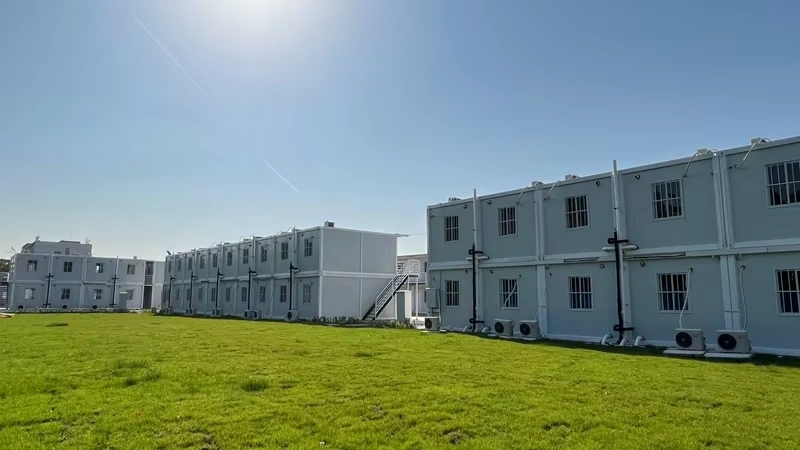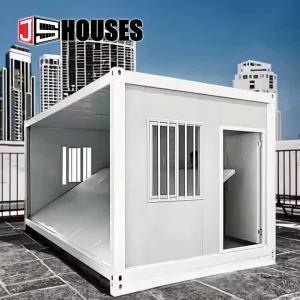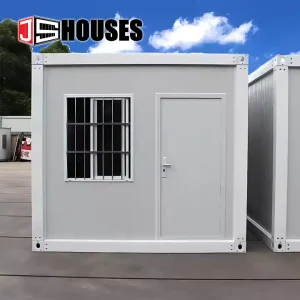Temporary housing after a hurricane: prefabricated container houses
Shelter in the Storm: Prefabricated Container Houses as a Solution for Post-Hurricane Housing
The aftermath of a hurricane is a landscape of profound loss and disruption. Homes, the fundamental units of security and community, are reduced to splinters and rubble. In this chaos, the provision of temporary housing becomes one of the most critical and complex challenges for disaster response. The traditional models—mass shelters in gymnasiums, flimsy tents, or even the protracted process of building temporary wooden structures—often present their own set of problems, from overcrowding and lack of privacy to significant delays and waste. In recent years, however, a compelling alternative has emerged from an unexpected origin: the global shipping industry. Prefabricated container houses, repurposed from the steel boxes that carry goods across oceans, are increasingly being recognized as a durable, scalable, and dignified solution for temporary housing in the wake of catastrophic hurricanes.

The Imperative for a Better Temporary Housing Model
Hurricanes like Katrina (2005), Sandy (2012), Maria (2017), and Ian (2022) have exposed the severe shortcomings of conventional post-disaster shelter strategies. Emergency shelters, while vital for immediate life-saving, are not a sustainable solution beyond a few days. They often lack privacy, pose health risks due to close quarters, and prevent families from beginning the psychological and practical process of recovery. The next phase typically involves the distribution of temporary housing units, such as FEMA’s traditional travel trailers or modular homes.
These solutions, however, have been plagued by issues. Trailers are highly vulnerable to wind and can be dangerous if placed in flood zones. Furthermore, the infamous case of FEMA trailers post-Katrina revealed widespread problems with indoor air quality due to off-gassing from formaldehyde-rich materials, creating a secondary health crisis. The procurement and deployment process for these units is also notoriously slow, often leaving survivors in limbo for months or even years. The “temporary” nature of these dwellings can inadvertently become semi-permanent, leading to the creation of depressed, trailer-park communities that hinder long-term recovery. It is within this gap of need and failed precedent that the prefabricated container house has found its purpose.

The Container: From Cargo to Comfort
At first glance, a standard shipping container—a corrugated steel box measuring either 20 or 40 feet in length—seems an unlikely candidate for a home. Yet, its inherent properties make it uniquely suited for the rigors of a post-disaster environment.
- Structural Integrity: Designed to be stacked high on container ships and withstand the harsh marine environment, shipping containers are incredibly strong, durable, and resilient. They possess a rigid steel frame that offers exceptional resistance to high winds—a crucial feature in hurricane-prone regions where aftershocks and subsequent storms can occur.
- Modularity and Standardization: Containers are built to universal ISO standards. This means they are designed to be easily transported by ship, train, and truck, and they can be quickly stacked and interconnected. This modularity allows for the creation of various layouts, from single-family units to multi-story apartment-like complexes for multiple families, all using the same fundamental building block.
- Availability and Cost-Effectiveness: The global shipping industry has a surplus of retired containers. With an estimated service life of 10-15 years for shipping, millions of containers are taken out of circulation annually. This makes them a relatively abundant and inexpensive raw material, reducing the initial cost of housing units.
- Speed of Deployment: Perhaps the most significant advantage in a disaster scenario is speed. While site preparation (utility connections, foundations) is still required, the core structure of the home—the container itself—arrives pre-formed. It can be rapidly modified in a factory setting and then transported to the site, where it is placed on pre-prepared footings and connected to utilities. This “plug-and-play” approach can cut down temporary housing deployment time from months to weeks.
The Transformation Process: Engineering Dignity and Safety
A raw container is not a home. The transformation process is where engineering and humanitarian design converge to create safe, livable, and dignified spaces. Post-hurricane modifications are particularly focused on habitability in a challenging climate.

- Site Preparation and Placement: Containers are typically placed on simple, cost-effective foundations like concrete piers or footings, which elevate them above potential floodwaters—a critical lesson learned from past hurricanes. Site planning involves creating communities with access roads, water, sewer, and electrical grids.
- Modification and Fabrication: In a factory-controlled environment, the containers undergo a meticulous conversion:
- Insulation and Climate Control: To combat the humid, hot climate of hurricane-affected areas, containers are heavily insulated with non-toxic spray foam or panel insulation. This is vital for regulating indoor temperature and preventing condensation, which can lead to mold—a serious health hazard. High-efficiency HVAC systems are installed to ensure comfort.
- Cut-Outs for Windows and Doors: Openings are precision-cut with steel reinforcement to maintain structural integrity. They are fitted with impact-resistant windows and secure, insulated doors, providing both safety and natural light.
- Interior Build-Out: The interior is fitted with moisture-resistant drywall or paneling. Layouts are designed to maximize space, typically including a combined living/sleeping area, a compact kitchenette, and a full bathroom. Durable, easy-to-clean finishes are used throughout.
- Utility Integration: Electrical wiring, plumbing, and sanitation systems are pre-installed. Many modern container units are also equipped with solar panels and rainwater collection systems to increase their self-sufficiency, a feature incredibly valuable in areas where the central grid has been destroyed.
- Safety and Accessibility: Units are designed with basic fire safety systems and can be made accessible for the elderly and people with disabilities, ensuring an inclusive recovery process.
Case Studies and Real-World Applications
The use of container housing is not merely theoretical; it has been tested in real-world post-hurricane scenarios with promising results.

- After Hurricane Maria in Puerto Rico (2017): The devastation was so comprehensive that traditional housing solutions were overwhelmed. Several initiatives, including one by the non-profit Friends of Puerto Rico, deployed modified container homes. These units provided not just shelter but also featured solar power and water purification systems, addressing the prolonged lack of electricity and clean water. They demonstrated how container homes could operate off-grid, a critical capability in shattered infrastructures.
- Conceptual Proposals for Resilient Communities: In the wake of disasters, architects and planners have proposed entire container-based transitional communities. These designs go beyond mere housing, incorporating shared community centers, medical clinics, and playgrounds built from the same modular units. This approach fosters a sense of community and normalcy, which is essential for mental health and social recovery.
Challenges and Considerations
Despite their significant advantages, container houses are not a panacea. Their implementation faces several practical and perceptual challenges.
- Logistics and Cost: While the raw container is cheap, the cost of modification, transportation, and site development can be substantial. Transporting heavy steel units requires robust logistics, which can be strained in a disaster zone with damaged infrastructure.
- Thermal Performance and Condensation: Steel is an excellent conductor of heat. Without superior insulation, a container home can become an oven in the sun. Proper, high-quality insulation and ventilation are non-negotiable and add to the cost and complexity.
- Perception and Cultural Acceptance: The aesthetic of a “metal box” can be difficult for some people to accept as a home, especially when they have lost a traditional house. There is a risk that residents will perceive them as impersonal or institutional. Effective community engagement and sensitive design that creates a warm, inviting interior are crucial to overcoming this stigma.
- The “Temporary” Dilemma: As with all temporary housing, there is a risk of containers becoming permanent fixtures by default if the permanent rebuilding process stalls. Clear timelines, community planning, and designs that allow for easy relocation or alternative use after their temporary service life are essential to prevent this.
The Future of Container Housing in Disaster Relief
The role of prefabricated container houses is evolving. Looking ahead, several trends promise to enhance their effectiveness further.

- Smart Design and Customization: Architects are creating increasingly sophisticated designs that use containers not just as boxes, but as structural elements for more ambitious and comfortable architectures, including two-story homes and layouts that feature courtyards and porches to foster community interaction.
- Integration with Circular Economy: The use of containers is inherently a form of recycling. This principle can be extended by using more sustainable and non-toxic building materials during modification and by designing units for disassembly and reuse after their temporary housing role is complete.
- Policy and Pre-Positioning: For container housing to be most effective, governments and aid organizations can pre-position modified units in hurricane-prone regions or have standing contracts with fabricators. This “pre-disaster recovery” planning would enable a dramatically faster response when the next storm strikes.
Conclusion: A Symbol of Resilience and Pragmatism
In the desperate search for shelter after a hurricane, the goal is not just to place a roof over someone’s head, but to provide a foundation for recovery—a safe, private, and dignified space where families can regroup, children can do homework, and a sense of normalcy can begin to be rebuilt. Prefabricated container houses, with their unique blend of strength, modularity, and speed, offer a powerfully pragmatic solution to the failures of past temporary housing models.
They are more than just recycled steel; they are a symbol of resilience and human ingenuity. By transforming a ubiquitous object of global trade into a sanctuary of safety and comfort, we can meet one of the most urgent needs of disaster recovery with efficiency and, most importantly, with respect for the dignity of those who have lost everything. As climate change increases the frequency and intensity of hurricanes, embracing innovative, robust, and scalable solutions like container housing is not just an option—it is an imperative for building a more resilient future.

